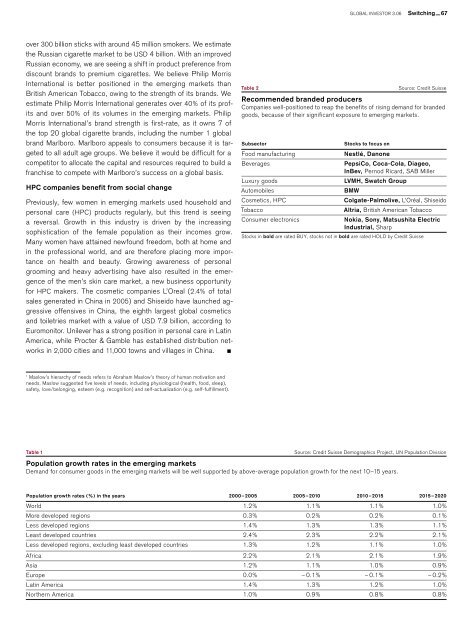Banking for 7 billion and 7 million
New challenges and opportunities of globalization Global Investor, 03/2006 Credit Suisse
New challenges and opportunities of globalization
Global Investor, 03/2006
Credit Suisse
Create successful ePaper yourself
Turn your PDF publications into a flip-book with our unique Google optimized e-Paper software.
GLOBAL INVESTOR 3.06 Switching — 67<br />
over 300 <strong>billion</strong> sticks with around 45 <strong>million</strong> smokers. We estimate<br />
the Russian cigarette market to be USD 4 <strong>billion</strong>. With an improved<br />
Russian economy, we are seeing a shift in product preference from<br />
discount br<strong>and</strong>s to premium cigarettes. We believe Philip Morris<br />
International is better positioned in the emerging markets than<br />
British American Tobacco, owing to the strength of its br<strong>and</strong>s. We<br />
estimate Philip Morris International generates over 40% of its profits<br />
<strong>and</strong> over 50% of its volumes in the emerging markets. Philip<br />
Morris International’s br<strong>and</strong> strength is first-rate, as it owns 7 of<br />
the top 20 global cigarette br<strong>and</strong>s, including the number 1 global<br />
br<strong>and</strong> Marlboro. Marlboro appeals to consumers because it is targeted<br />
to all adult age groups. We believe it would be difficult <strong>for</strong> a<br />
competitor to allocate the capital <strong>and</strong> resources required to build a<br />
franchise to compete with Marlboro’s success on a global basis.<br />
HPC companies benefit from social change<br />
Previously, few women in emerging markets used household <strong>and</strong><br />
personal care (HPC) products regularly, but this trend is seeing<br />
a reversal. Growth in this industry is driven by the increasing<br />
sophistication of the female population as their incomes grow.<br />
Many women have attained newfound freedom, both at home <strong>and</strong><br />
in the professional world, <strong>and</strong> are there<strong>for</strong>e placing more importance<br />
on health <strong>and</strong> beauty. Growing awareness of personal<br />
grooming <strong>and</strong> heavy advertising have also resulted in the emergence<br />
of the men’s skin care market, a new business opportunity<br />
<strong>for</strong> HPC makers. The cosmetic companies L’Oreal (2.4% of total<br />
sales generated in China in 2005) <strong>and</strong> Shiseido have launched aggressive<br />
offensives in China, the eighth largest global cosmetics<br />
<strong>and</strong> toiletries market with a value of USD 7.9 <strong>billion</strong>, according to<br />
Euromonitor. Unilever has a strong position in personal care in Latin<br />
America, while Procter & Gamble has established distribution networks<br />
in 2,000 cities <strong>and</strong> 11,000 towns <strong>and</strong> villages in China. <br />
Table 2<br />
Source: Credit Suisse<br />
Recommended br<strong>and</strong>ed producers<br />
Companies well-positioned to reap the benefits of rising dem<strong>and</strong> <strong>for</strong> br<strong>and</strong>ed<br />
goods, because of their significant exposure to emerging markets.<br />
Subsector<br />
Stocks to focus on<br />
Food manufacturing<br />
Nestlé, Danone<br />
Beverages<br />
PepsiCo, Coca-Cola, Diageo,<br />
InBev, Pernod Ricard, SAB Miller<br />
Luxury goods<br />
LVMH, Swatch Group<br />
Automobiles<br />
BMW<br />
Cosmetics, HPC<br />
Colgate-Palmolive, L’Oréal, Shiseido<br />
Tobacco<br />
Altria, British American Tobacco<br />
Consumer electronics<br />
Nokia, Sony, Matsushita Electric<br />
Industrial, Sharp<br />
Stocks in bold are rated BUY, stocks not in bold are rated HOLD by Credit Suisse<br />
1<br />
Maslow’s hierarchy of needs refers to Abraham Maslow’s theory of human motivation <strong>and</strong><br />
needs. Maslow suggested five levels of needs, including physiological (health, food, sleep),<br />
safety, love/belonging, esteem (e.g. recognition) <strong>and</strong> self-actualization (e.g. self-fulfillment).<br />
Table 1<br />
Source: Credit Suisse Demographics Project, UN Population Division<br />
Population growth rates in the emerging markets<br />
Dem<strong>and</strong> <strong>for</strong> consumer goods in the emerging markets will be well supported by above-average population growth <strong>for</strong> the next 10 –15 years.<br />
Population growth rates (%) in the years 2000 – 2005 2005 – 2010 2010 – 2015 2015 – 2020<br />
World 1.2% 1.1% 1.1% 1.0%<br />
More developed regions 0.3% 0.2% 0.2% 0.1%<br />
Less developed regions 1.4% 1.3% 1.3% 1.1%<br />
Least developed countries 2.4% 2.3% 2.2% 2.1%<br />
Less developed regions, excluding least developed countries 1.3% 1.2% 1.1% 1.0%<br />
Africa 2.2% 2.1% 2.1% 1.9%<br />
Asia 1.2% 1.1% 1.0% 0.9%<br />
Europe 0.0% – 0.1% – 0.1% – 0.2%<br />
Latin America 1.4% 1.3% 1.2% 1.0%<br />
Northern America 1.0% 0.9% 0.8% 0.8%

















